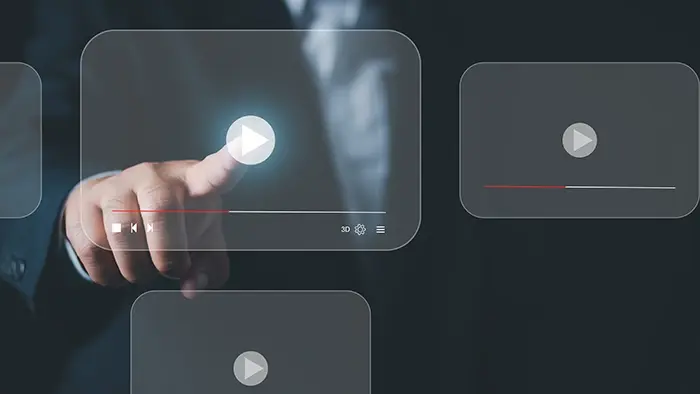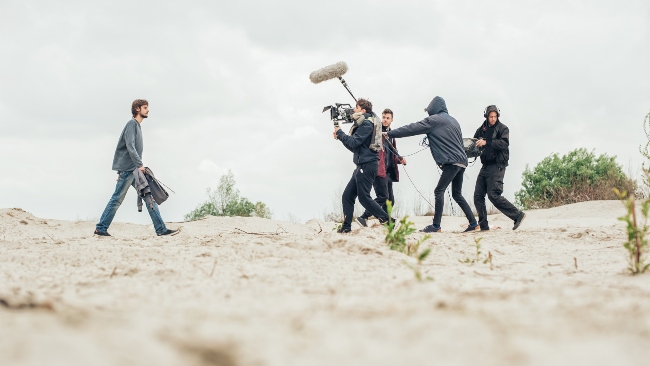The Top Video Production Best Practices & Trends to Watch in 2022
Editor's note: This post originally published in 2020 and was updated in September 2023. Did you know that consumers are watching over 5 billion...
4 min read
 Ed Heil
:
October 16, 2025
Ed Heil
:
October 16, 2025
Everyone's launching a video podcast these days. It looks easy from the outside — grab a mic, hit record, post it online. But here's the truth: most video podcasts fail because people skip the foundation and jump straight to production.
The ones that succeed? They go slow to go fast.
Before you think about equipment or editing software, answer this: who are you talking to?
Too many podcasts try to be everything to everyone. They cover "business and life and health and maybe some sports." The result? Nobody knows what the show is actually about, and the audience never materializes.
Your target audience needs to be specific. Not "entrepreneurs," but "second-time founders building SaaS companies." Not "parents," but "working moms navigating career pivots." The tighter your focus, the easier everything else becomes.
Once you know your audience, determine your angle. What unique and specific perspective are you bringing? What ground are you covering that others aren't? These boundaries might feel limiting but they will actually set you free, so to speak. When a topic sounds fun but falls outside your scope, you can confidently skip it and stay on track — avoid chasing those shiny objects.
Think of your creative brief as a business plan for your podcast. It's the blueprint that guides every creative decision and becomes the roadmap for your show’s producer who makes sure each episode runs smoothly.
A strong creative brief defines your audience, the primary benefit they'll get from watching or listening, the tone and style of your show, the topics you'll cover (and won't cover), and how you'll measure success. It should also nail down operational details: which platforms you'll use, what social channels you'll leverage for distribution, and how often you'll release episodes.
Here's why this matters: without a creative brief, every decision becomes a debate. Should we post on TikTok? Is this guest right for the show? Should we add a new segment? With a brief, these questions answer themselves. You've already done the thinking.
Going slow at this stage means you'll move faster later. You won't waste time second-guessing decisions or rebuilding your show's identity every few months.
Once you have your brief, map out your content calendar. Identify possible guests you can schedule in advance — people who fit your show's mission and are actually attainable. Chances are you’re not going to go “viral” so stay true to the goal of the podcast and select guests that will help add value to your listeners.
This is where most podcasts stumble. They launch with a few guests lined up, then scramble to fill slots week after week. The quality suffers. The stress builds. Eventually, the show fades out.
Instead, think strategically. Which guests make sense for which episodes? Are there seasonal topics worth planning around? Can you batch recordings to stay ahead? Planning doesn't mean rigidity — you can stay flexible when schedules shift — but it does mean you're never scrambling at the last minute.
If you can schedule a pre-production call with your guests, do it. Even 15 minutes makes a difference.
Use this time to discuss the episode, ask some preliminary questions, and gauge how conversational they are. You'll find out really fast if there are topics to avoid, stories that will be helpful for them to share, or areas where they need more structure. You can also do additional research before the recording date.
The more prepared you are, the smoother the conversation will flow. Plus, your guest will thank you. They will feel more comfortable, and you'll get better content. Win-win.
This is the part that takes longer than anyone expects, so put on your “operations” hat and dive into production timelines.
As any process oriented video editor will tell you, editing video isn't like editing audio. You're dealing with visuals, pacing, graphics, music, and show intros. If you're serious about video podcasting, you need to know what your show will look and feel like. Many podcasts today function like online talk shows — what's yours going to be?
Plan for this in advance. Who's handling the editing? What tools are you using? What's your timeline from recording to publication? If you've done the creative brief work upfront, decisions about graphics, music, and visual style become much clearer. You're not starting from scratch every episode.
Budget time and resources accordingly. Post-production shouldn’t be an afterthought — it's where your podcast comes to life.
One of the questions you need to ask at the outset, and continue to ask after each episode is this — How will you know if your podcast is working?
Seeing yourself online isn't a metric. Neither is "getting content out there." You need benchmarks that tell you if you’re accomplishing your goal — or at least on the right path.
Start modestly. Building an audience takes time, especially for niche topics. But niche doesn't mean small impact — a focused audience of 50 engaged viewers can be far more valuable than 5,000 passive ones.
Decide what success looks like for your show. Are you tracking views? Downloads? Email signups? New client inquiries? Pick metrics that align with your goals, set them up from day one, and stay open to adjusting as you learn what actually drives results.
Launching a video podcast isn't hard. Launching one that lasts and delivers results? That requires strategy and a benefit for the listener or viewer.
Go slow to go fast. Define your audience and angle. Build a creative brief that guides every decision. Plan your content calendar and prep your guests. Budget for post-production. Set clear success metrics.
Above all else, make sure your podcast is helpful and informative. What makes the best podcasts worth listening to is that they are meaningful to the listener. When you are able to share your unique perspective, provide valuable insights and make every decision based on the benefit to the audience, you’ll be in good shape. Do the hard work upfront, and you won't have another podcast that fizzles out after six episodes. You'll have a show with direction, purpose, and staying power — one that actually connects with the people you're trying to reach.

Editor's note: This post originally published in 2020 and was updated in September 2023. Did you know that consumers are watching over 5 billion...

You’ve wrapped a video project, the final file’s in your inbox, and it looks fantastic. But now what?

Editor's Note: This blog was updated for accuracy and relevance on August 27, 2024. Here's a multiple-choice question for you. When a movie ends, and...